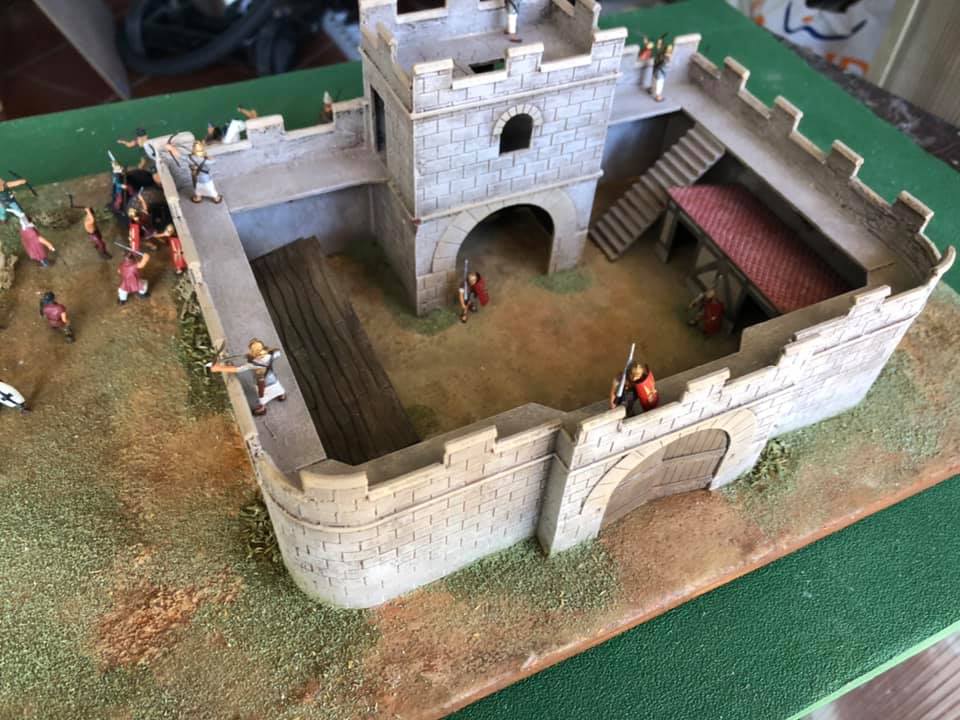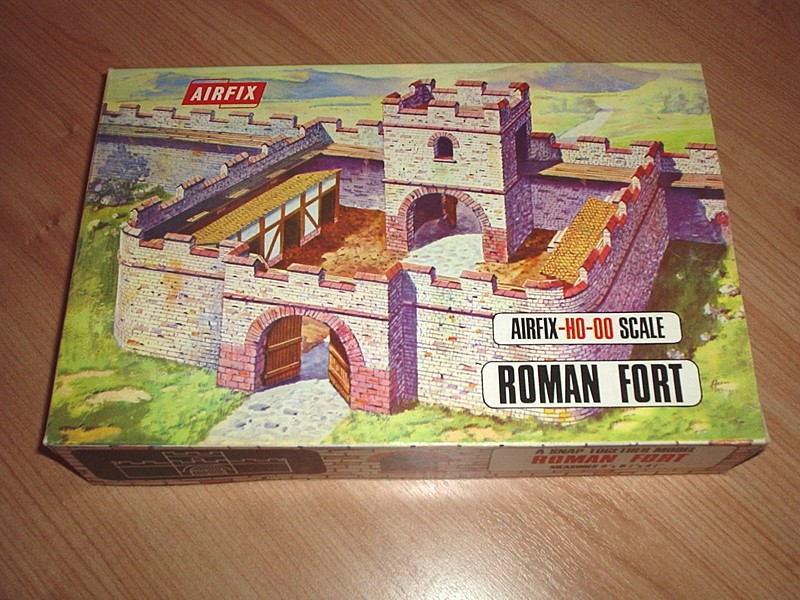Introduction
The Airfix Roman Fort is a classic and beloved kit in the historical modeling community, offering a detailed and accessible way to explore the world of ancient Rome. Released as part of Airfix’s Historical Series in 1:76 scale (OO/HO), the Roman Fort captures the architectural essence and strategic function of a Roman military outpost. For educators, hobbyists, and history buffs alike, it presents an ideal platform to engage with ancient history hands-on.

With a design based on archaeological reconstructions of Roman forts across Britain and continental Europe, the Airfix Roman Fort allows modelers to build a compact but representative piece of Roman military infrastructure. Combined with Roman soldier figures (sold separately or bundled in some sets), the fort becomes the centerpiece for dioramas, wargaming, or educational displays.
Historical Context: Roman Forts on the Frontier
The Roman Empire, at its height, spanned much of Europe, North Africa, and parts of the Middle East. Securing this vast territory required a network of roads, outposts, and forts (known as castra) to house and support legions and auxiliaries.
In Britain, forts such as Vindolanda, Housesteads, and Birdoswald—located along Hadrian’s Wall—are enduring reminders of Rome’s frontier defense system. These forts were typically constructed using timber and turf initially, later replaced with stone as stability and permanence increased.
A typical Roman fort housed around 500–1000 soldiers and featured:
- Perimeter defenses (palisade walls, ditches, gates)
- Barracks for soldiers
- Granaries and storerooms
- Headquarters (principia)
- Commander’s house (praetorium)
- Workshops (fabrica)
- Stables and baths
The Airfix Roman Fort captures many of these elements, allowing hobbyists to recreate an authentic Roman frontier setting.
Set Contents and Features
The Airfix Roman Fort kit is molded in hard plastic and includes a range of structural elements that fit together to form a complete enclosed fort. The layout is modular, allowing modelers to rearrange walls and buildings based on their desired setup.
Key Components
- Walls and Towers
- Tall wooden palisade walls with walkways on the interior
- Four corner towers and gate towers with battlements
- Defensive ditches (represented in the base or added separately)
- Gates
- A main gate with twin towers
- Large enough to place figures for sentry duty or patrols
- Gate doors may be left open or closed for effect
- Internal Buildings
- Simple barrack-style huts
- Storehouse or granary with pitched roof
- Headquarters building (sometimes scratch-built by hobbyists to supplement the set)
- Base and Terrain
- The fort walls are usually mounted on a flat base representing the camp perimeter
- Hobbyists often create their own terrain using foam board, grass mats, or textured paint
The fort is designed for compatibility with Airfix’s HO/OO scale Roman Infantry and other accessories. The plastic parts are cleanly molded and respond well to painting, dry brushing, and weathering.
Painting and Detailing the Roman Fort
Building and painting the Roman Fort provides a satisfying experience for modelers of all skill levels. While the unpainted kit already gives a strong impression of structure, painting transforms it into a realistic and visually compelling scene.
Suggested Color Scheme
- Walls and Towers: Timber brown with dry-brushed highlights to simulate weathered wood
- Roofs: Slate grey or terra cotta, depending on regional influence
- Ground/Base: Earth tones with static grass or gravel for realism
- Doors and Ladders: Lighter wood or grey-washed for age effect
- Metal Details: Bronze or iron for hinges and gate hardware
Advanced modelers may add details like moss, broken planks, or burn marks to indicate past battles or siege damage.
Diorama Possibilities
The Airfix Roman Fort serves as an ideal centerpiece for a historical diorama. When paired with figures, accessories, and terrain, it can depict a range of scenes from Roman military life.
Diorama Ideas
- A Fort Under Construction
- Roman engineers (using civilian figures with tools)
- Timber frames and scaffolding
- Piles of logs and wheelbarrows
- Daily Life in the Fort
- Soldiers training or standing on guard
- Officers giving orders in the courtyard
- Animals (dogs, horses) in stables or yard
- A Fort Under Siege
- Celtic or Germanic warriors attacking the walls
- Flaming arrows, siege ladders, broken gates
- Defenders with shields and pila (javelins)
- Winter on the Frontier
- Snow effects using white paint, baking soda, or specialist modeling snow
- Fires burning in braziers
- Soldiers in cloaks patrolling the walls
By incorporating miniatures, natural elements (trees, rocks), and even sound modules, the Airfix Roman Fort becomes a dynamic historical display.
Educational Value
The Roman Fort model serves as a powerful educational tool in classrooms, museums, and homeschool environments. Teachers use it to explain Roman military organization, engineering, and life on the frontier.
Topics the Model Helps Illustrate
- Architecture: Roman engineering, fort design, and modular construction
- Military Strategy: Defense systems, troop deployment, and border control
- Daily Life: The lives of legionaries, their routines, and their interactions with local populations
- Romanization: The spread of Roman culture through military occupation
Students can be involved in building and painting the model as part of an interactive history unit.
Wargaming and Custom Scenarios
Wargamers often incorporate the Roman Fort into scenarios for skirmish or battle games. Whether using custom rules or established systems like Hail Caesar or De Bellis Antiquitatis, the fort can serve as a defensive objective or a staging area.
Scenario Ideas
- Hold the Fort: A Roman garrison must survive waves of barbarian attacks until reinforcements arrive.
- Escape from the Fort: A small Roman patrol must break through enemy lines after a fort is overrun.
- Recruitment and Rebellion: The fort is a hub for raising local auxiliaries—until a rebellion breaks out.
Adding gates that open and close, removable wall sections, and hidden tunnels adds tactical depth to games.
Modifying and Expanding the Fort
Advanced hobbyists often modify or expand the base Airfix Roman Fort to create larger installations. Using balsa wood, styrene, or 3D-printed parts, modelers can build:
- Amphitheaters
- Bathhouses
- Stables and granaries
- Watchtowers and signal beacons
- Connected roads and bridges
Incorporating figures from other Airfix ancient sets—like Roman Infantry, Ancient Britons, or even chariots—enriches the scene and increases realism.
Collectability and Nostalgia
First released in the 1970s, the Airfix Roman Fort is a nostalgic favorite for many hobbyists who grew up during the golden age of plastic model kits. Though not always in constant production, it is periodically re-released due to popular demand.
Collectors prize the original boxed versions, often identifiable by their classic artwork and vintage Airfix branding. These kits are frequently traded at model fairs and online marketplaces, sometimes at premium prices.
Conclusion
The Airfix Roman Fort is much more than just a model—it’s a gateway into the ancient world. Combining history, creativity, and craftsmanship, it offers hobbyists the opportunity to construct, customize, and explore one of the most iconic military structures of antiquity.
Whether used for wargaming, educational display, or pure modeling enjoyment, the Roman Fort remains a classic piece in Airfix’s lineup. With its modular design, historical accuracy, and endless customization options, it invites modelers of all ages to relive the glory, discipline, and challenge of Rome’s distant frontiers.

